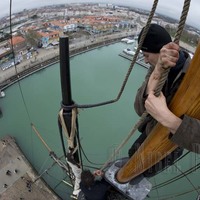Conference Presentations by David Fabre

"The presentation gives preliminary information on the shipwrecks of the submerged Egyptian city ... more "The presentation gives preliminary information on the shipwrecks of the submerged Egyptian city of Heracleion-Thonis excavated by the European Institute of Underwater Archaeology (IEASM). Underwater surveys started in 1996 in the Bay of Abukir allowed determining the outline of the submerged Canopic region, the circumstances and chronology of its submersion. From the 8th century B.C.E., this town was the custom and border post, and the emporion which controlled access to the Canopic channel, traded with the Greek regions and supervised foreign ships. More than sixty ships dating from the 6th to the 2nd centuries B.C.E. were discovered in the port regions and in the canals of the city bringing evidence on the intense maritime and fluvial activity in this coastal region. Initial analysis of the distribution of the ships of Heracleion-Thonis and some observations on their constructional peculiarities and on the choice of the building material is proposed. Ship 17 of Heracleion-Thonis is the first vessel to be excavated and is thoroughly analysed in the PhD thesis of A.Belov entitled ‘Studies of the Egyptian naval architecture of the Late Period. New archaeological evidence and an attempt at a 3D reconstruction’, which will be examined at the University of Bordeaux in autumn 2013. The ship shows many similarities with the description by Herodotus of the Egyptian river-going ship ‘baris’ (Histories, 2.96, c.450 BC).
David FABRE
Doctor in Egyptology, Université Paul Valéry – Montpellier III (France)
European Institute for Underwater Archaeology
fabre.david@free.fr
Alexandre BELOV
Center for Egyptological Studies of Russian Academy of Sciences
European Institute for Underwater Archaeology
belov.alexandre@gmail.com
"
""The accumulation of more than 60 well-preserved shipwrecks dating from 14th to 2nd centuries BC... more ""The accumulation of more than 60 well-preserved shipwrecks dating from 14th to 2nd centuries BC present great interest for the studies of ancient naval architecture. One of the most important questions here is the transition from the indigenous Egyptian to Greco-Roman boatbuilding tradition. Preliminary studies of the ships already have shown a choice of indigenous wood and many specific constructional features. The excavation of the shipwreck 17 is supposed to be continued in nearest seasons and simultaneously a project of a 3-dimensional reconstruction of its hull is being planned by IEASM as a part of a PhD thesis of A.Belov under supervision of Dr.R.Vergnieux of the Institute Ausonius of University of Bordeaux-3.
Future studies will allow us understanding more not only the architecture of the ships but their place in Egyptian history as well. ""
Papers by David Fabre

International Journal of Nautical Archaeology 42.1: 44-59, Mar 2013
Between 1998 and 1999 three excavation campaigns were undertaken on a shipwreck at the now-submer... more Between 1998 and 1999 three excavation campaigns were undertaken on a shipwreck at the now-submerged site of the ancient Portus Magnus, off the coast of Alexandria. The site, close to the island of Antirhodos, was identified through geophysical and archaeological surveys carried out by the Institut Européen d’Archéologie Sous-Marine (IEASM), directed by Franck Goddio. The remains of the ship lie c.5 m deep and are spread over c.350 sqm. No cargo has been found. Artefacts recovered, the details of the ship's architecture and radiocarbon dating all suggest it sunk between the end of the 1st century BCE and the 1st century CE. Its dimensions correspond to those of commercial ships of the Roman era. Identification of the wood used contributes significantly to our knowledge of materials used in naval architecture of this period.









Uploads
Conference Presentations by David Fabre
David FABRE
Doctor in Egyptology, Université Paul Valéry – Montpellier III (France)
European Institute for Underwater Archaeology
fabre.david@free.fr
Alexandre BELOV
Center for Egyptological Studies of Russian Academy of Sciences
European Institute for Underwater Archaeology
belov.alexandre@gmail.com
"
Future studies will allow us understanding more not only the architecture of the ships but their place in Egyptian history as well. ""
Papers by David Fabre
David FABRE
Doctor in Egyptology, Université Paul Valéry – Montpellier III (France)
European Institute for Underwater Archaeology
fabre.david@free.fr
Alexandre BELOV
Center for Egyptological Studies of Russian Academy of Sciences
European Institute for Underwater Archaeology
belov.alexandre@gmail.com
"
Future studies will allow us understanding more not only the architecture of the ships but their place in Egyptian history as well. ""